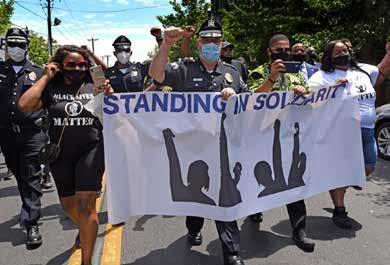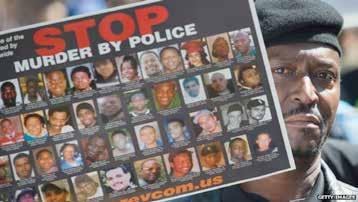
13 minute read
Another farm invasion in Zimbabwe despite promises
Agovernment official last month invaded a farm owned by a white commercial landowner in Zimbabwe in yet another twist that highlights the policy inconsistencies in Zimbabwe’s controversial land reform programme. This official occupies this property at a time when the government has undertaken to compensate white farmers. The farm invasion comes just a few weeks after the government said it will allow some white farmers that lost their land to the violent land reform programme to return to their farms. In August, Zimbabwe committed to pay $3.5bn in compensation to local white farmers whose land was forcibly taken by the government to resettle black families, moving a step closer to resolving one the most divisive policies of the Robert Mugabe era. The government also said foreign white farmers settled in Zimbabwe whose land was seized under the controversial programme can apply to get it back and will be offered land elsewhere if compensation proves unworkable. But on Friday Martin Grobler, who had a farm in Ruwa, 30km outside the capital, Harare, was evicted after he was given 24 hours’ notice.
Grobler said Ivy Rupandi, a government official with the ministry of lands, told him to move out of the property with
Advertisement

immediate effect. Grobler said Rupandi and an accomplice brought a truckload of police officers and a sheriff of the high court before they moved his property from the farmhouse. “Rupandi told me that she was now the new owner of the farm before they brought a lorry load of people and a sheriff of the court,” he said. “These people told us to move out right away.” On this development, the ministry of information said it would investigate the issue amid a public outcry over the invasion of the farm. In a statement, the ministry said: “We have been made aware of a video depicting an eviction of a farmer and his family. Government is trying to establish the facts behind this matter. What is known so far is that there is a legacy legal issue between the parties and the matter is being dealt with by the courts.” Recently, the government indicated that it was willing to work with evicted white farmers in partnerships to make land productive as vast tracts of land remain underutilized after the land reform programme. Once a breadbasket of Southern Africa, Zimbabwe’s food production has plummeted, forcing the country to import basic foodstuffs. A land audit carried out by the government exposed huge irregularities in the allocation of farms, with some children as young as 10 years old reportedly getting land, while prominent officials own multiple farms. Zimbabwe’s land reform still divides public opinion in the country as thousands of black families benefited but the number of white farmers has dropped to just over 200 from 4,500 when land reforms began in 2000.
RACISM, RACIAL JUSTICE AND THE GLOBAL REACH OF THE BLACK LIVES MATTER MOVEMENT
The Black Lives Matter movement has sparked renewed protests and debates in the US about racial injustice and institutionalized discrimination. In this blog post, Felix Mukwiza Ndahinda, honorary Associate Professor at the University of Rwanda, reflects on the relevance of this movement for Europe and the need for European countries to confront their domestic racial issues. On Saturday 6 June 2020, I was standing in a queue,

waiting for my turn to buy fish at Tilburg’s Saturday open market when the seller bluntly proclaimed that me and another black man standing nearby could get three pieces of fish for the price of two because, he said, we were “the discriminated against” (de gediscrimineerde). I paused, didn’t know how to react or whether to accept or refuse the special offer. My dilemma was accentuated by complaints by two white ladies of a certain age for being left out of this black-friendly treatment. In a split second, my environment became a microcosm of the affirmative action debates. The incident made me think about the global reach of the Black Lives Matter movement and the boundaries of the struggle for racial justice. Building on this and other considerations detailed below, the present piece seeks to explore the significance of the Black Lives Movement in Europe. The atrocious killing of George Floyd by a Minneapolis policeman on 25 May 2020 generated global condemnation. Spontaneous demonstrations took place in hundreds of cities across the United States, denouncing this and similar killings of black men and women by the police or white vigilantes, often with impunity. Outside the US, thousands of individuals from all walks of life braved Covid-19 lock downs to hold demonstrations in London, Paris, Amsterdam, Brussels, Rome, Budapest, Tokyo, Sydney, Auckland and numerous other cities. They denounced George Floyd’s and similar killings and called for the eradication of structures feeding racism. Black Lives Matter, a slogan used after the 2013 killing of Trayvon Martin, has become a core message and global movement for racial justice. That message singles out police brutality, racial profiling and inequities in the criminal justice system, what Michelle Alexander calls the New Jim Crow.
The killing of Floyd, and other African Americans in recent years are portrayed as symptomatic of structural violence that perpetuate white privilege and reinforce black peoples’ marginalization. They fit in a continuum of violence that stretches back to slavery, lynching and reification of black people across US history and beyond. Spontaneous protests across the world involving large numbers of members of nonblack communities are unprecedented: they have inspired new conversations about race and generated policy engagement to tackle deep-rooted sources of bigotry targeting afro-descendants and minority groups in comparable situations. Inspired by the demonstration and a call by prominent UN officials of African descent , the UN held a debate on “racism, systemic racism, police brutality against persons of African descent” on 17 June 2020. Despite pressure from the US not to be singled out, it recommended the creation of a commission of inquiry on the subject-matter.

Events held around the world have often expressed solidarity with demonstrators in the United States. In many countries, protesters have also been linking the plights and struggle for equality by black people in the US to domestic dynamics in racial relations. In a November 2018 report entitled “Being Black in the EU”, the European Union
Agency for Fundamental Rights (FRA) found that 30% of respondents had experienced what they perceived as racist harassment in the five years preceding the survey, while 5% of respondents experienced what they perceived as racist violence. The findings led FRA to conclude that being Black in the EU meant “facing entrenched prejudice and exclusion”.
In the United Kingdom, over 200 protests were held in cities across the country during the first weekend of June 2020. Protesters invoked the wrongful killings of several black men in recent years by law enforcement, drawing parallels between institutionalized racism in the US and the UK. In Bristol, they toppled and threw to the sea the statute of Edward Colston, a prominent slave trader. Even a quasi-sacred figure in European history such as Winston Churchill was not spared an inquisition into his questionable legacy on race. Recent articles, books, documentaries – often featuring intimate accounts by figures such as David Olusoga or Afua Hirsch – have been revisiting the British imperial ramifications of contemporary racism targeting black “subjects of her majesty” and dissected the many faces of resistance to change. In other countries like France, similar debates have been taking place. French actor of African descent Omar Sy wrote a powerful tribune elaborating on the domestic relevance of the current racial injustice debate by listing names of black and other minority figures killed in recent years under questionable circumstances. They evocatively include Adama Traoré who died in 2016 in police custody by asphyxiation, leading to mass protest and riots. In Belgium, statues of King Leopold II were defaced, daubed in the colour of blood or removed, reigniting debates about the monarch’s colonial atrocities in Congo. King Philippe took the historical step of acknowledging the reality of atrocities committed under the rule of his forefathers.
Closer to my fish market story, demonstrations took place in several cities across the Netherlands including Tilburg where global and domestic racial issues were raised. The visibility of Afro-descendants in the Netherlands remains rather limited. Recent years have seen protests associated with the Zwarte Piet (Black Piet) controversy. This Dutch version of the Saint Nicolas mythology celebrated annually on 5 December often features a white horse-riding Sinterklaas accompanied by Zwarte Piet “helpers”, essentially other white men/women wearing black face and red lips. Considered as a harmless traditional practice by a large section of Dutch society, the stereotypical Zwarte Piet figure is considered as highly offensive by Black people in the country and abroad. The globally projected liberal, tolerant and accommodative image of Dutch society can hardly be reconciled with the Zwarte Piet figure. Yet, societal ambivalence towards this and deeper issues about race relations in the country are captured by Prime Minister Rutte’s positions on the issue: he defended Zwarte Piet in the past, then stated that he had evolved on the issue after the Black Lives Matter protests but still believed that a passive approach of letting the issue fade away over the years was the better answer than any active governmental involvement in the matter. I have always felt uncomfortable

around the Sinterklaas-Zwarte Piet celebrations and faced deep dilemmas about involvement of my children in the celebrations. I believe the government should play a proactive role in freeing Zwarte Piet from the twisted chains of colliding tradition and memories of racial injustice. But the Zwarte Piet controversy mirrors deeper issues of race and racial justice in the Netherlands. As far as I can remember watching international football, I have been captivated by the constant presence of players of African descent in the Dutch team. That image sharply contrasts with the current all-white Dutch Cabinet or the very limited representation of Afrodescendants in corporate boardrooms or any other seat of authority in the country. During more than a decade of working in a Dutch academic environment, I have encountered very few scholars of Surinamese, Antillean or, more generally, African descendance.
Examination of parallels and differences in race relations between the Netherlands, Europe and the US requires deeper studies that go beyond the scope of this analysis. Suffice here to note that personal experiences and encounters taught me that Dutch society is far from immune from racial biases. In January 2006, I had just started my fourth month as a PhD research at Tilburg University when I was rounded by the police and taken to the station, with little information, because I looked like a suspect they were looking for – which, as I learned later, was a stretch. In other incidents, I was denied entrance in clubs for “wearing wrong shoes” or asked to produce an ID where white cohort friends weren’t. More revolting for an academic, I once received a written evaluation of a proposal submitted to the Dutch Research Council (NWO) patronizingly stating that my purported ethnicity, something I am never vocal about, was a liability for the proposed research.
Continued from Page 59
Liberal European societies are keen to profess their rejection of racism, their adherence to, and practices of, equality, humanitarianism and philanthropy. Yet, over the years, I, and others, have experienced the discomforts of engaging in a serious conversation about Europe’s dark past of slavery, colonialism, imperialism, structural racism and white privilege that persist today. While my Belgian friends are keen to discuss any aspects of the Hutu, Tutsi and Twa identities, very few are genuinely open to engaging in a sustained conversation revisiting their country’s colonization in Central Africa or any possible parallels between their domestic identity politics (Flemish-Walloon relations) and racialisation and antagonisation of ethnicity in their colonies. Those of us educated in former colonies were forced to learn a lot about European history. I was surprised to learn about the gaps in educational curricula of former colonial powers regarding their own imperial history. Recent protests sent a message that in order to properly respond to entrenched racism, it is essential to dismantle the structures that feed it. While some symptomatic issues of racism, like addressing inequities in law enforcement and criminal justice system, may be fixed in the short term with enough good will, tearing down other structures erected over centuries involve a longer journey. A first step requires to revisit the history of racism, racial inequalities and theories of racial supremacy. An informed understanding of the origins of black face and other insulting or stereotypical representations of the black people across history can hardly accommodate any excuses for black face in 2020. Revisiting that past is also necessary for understanding the multiple layers of systemic racism, what needs to be done to uproot it and who bears the responsibility. Remedying structural racism entails confronting historical injustices, a task that requires an honest dialogue between all stakeholders. Ultimately, it requires a genuine levelling of the playing field whereby opportunities are distributed equally to all regardless of race, class and creed. Here again, all members of society, particularly those holding positions of power and privilege, can and should genuinely contribute to effecting the much needed change in the direction of substantive equality. Finally, it requires those disadvantaged by structural racism to unwaveringly commit to throwing off the chains of their subjugation. In the words of the great Bob Marley, that may require emancipation from mental slavery by freeing minds of received ideas about black inferiority. A lasting legacy of structural racial conditioning is, indeed, the internalization of inferiority whereby many black people hold views of themselves or other black people as inferior and undeserving of equal treatment. Hence, while many Africans experience racism and other indignities in the Global North, they are often less favourably treated than a white individual in their own countries (of origin) where decolonisation did not affect white privilege. A few years back, a friend of mine and I were turned away from watching Premier League football games at a “Greek Club” in Arusha-Tanzania under the pretence that entrance was reserved for members, a code for whites as we later learned. The Congolese writer and researcher Trésor Kibangula related a similar incident in November 2019 at a Kinshasa Shoprite Supermarket where he was asked by a local security guy to leave his backpack in a locker before entry while his white colleague was not, because those were the instructions the security personnel had received. Dismantling the structures of racism therefore requires a comprehensive approach in tackling the root causes and its visible and invisible, conscious and unconscious, active and passive manifestations. Ultimately, ending racism may require revisiting the epistemologies of race in dominant languages we use. Since the notions of black (umwirabura) and white (umuzungu) as “racial” categories are carried differently from the corresponding black (umukara) and white (umweru) colours in Kinyarwanda, I have always resisted describing myself as black or, even worse, as a person of colour. My skin complexion is definitely not literally black! Fundamentally, my discomfort with the label is mostly motivated by associations of blackness with evil in European languages – e.g. English, French, German, Dutch -whereas whiteness translates innocence and purity. Ultimately, tearing down the structures of racialism require unlearning the epistemologies of race. In this regard, European languages have a lot to learn from African languages. Revisiting a contentious past of racial injustices to construct just historical memories might represent the new frontier for transition justice. Dr. Felix Mukwiza Ndahinda is a researcher, consultant and honorary Associate Professor at the University of Rwanda. He worked as the Director of the Research, Policy and Higher Education Program (Aegis Trust); an Assistant Professor at Tilburg Law School and an Associate Legal Officer for the International Criminal Tribunal for Rwanda in ArushaTanzania. He holds a PhD from Tilburg University (2009) and an LLM from the Raoul Wallenberg Institute of Human Rights (Sweden-2006). His academic interests cover indigenous rights/ issues, transitional justice, peace building, identity politics and mass/collective victimization.

Originally published in The Leuven Transitional Justice Blog which is a group blog produced by members of the Leuven Institute of Criminology at the University of Leuven (KU Leuven), Belgium.










